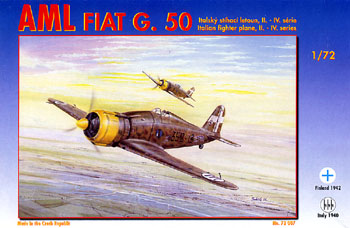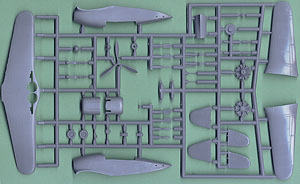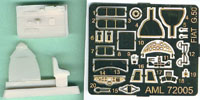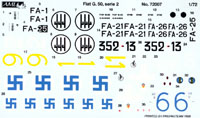


 AML's
1/72
AML's
1/72
Fiat G.50 Series II-IV
By Chris Banyai-Riepl
History
The Fiat G.50 could have been an excellent fighter, but multiple design changes and requirements kept it from becoming what it could have been. The G.50 was Italy’s first all-metal fighter fitted with retractable landing gear, and while not as maneuverable as the Macchi MC.200 (its main competition), it was more than adequate for the role. Examples from the first batch (Series I) quickly found their way to Spain, where they fought in the Spanish Civil War alongside Bf109s of the Condor Legion. It was during this conflict that one of the major shortcomings of the G.50 became apparent: visibility. The view from the cockpit of the G.50 was decidedly inferior to that of the Bf109 and even the I-16. The other main problem with the G.50 was that of armament, with only light machine guns being fitted. During the Spanish Civil War and the early years of the Second World War, there was little thought given to cannon-armed fighters in Italy. Thus, when the Bf109 was moving towards 20mm cannons, which were lighter and had about the same rate of fire, the G.50 kept its 12.7mm machine guns. This difference would become more and more apparent as the war dragged on, until the G.50 was hopelessly outclassed.
The Kit
AML has released another Fiat G.50, this time the Series II-IV. Like the earlier Series I G.50, this kit is molded in light gray plastic and has both resin and brass details. While the basics are the same as the Series I kit, there are several additions to the kit to make it into an accurate Series II-IV.
 Starting
with the cockpit, the sidewall detailing is molded into the fuselage halves
while the rest is provided in resin and brass. The cockpit floor is resin,
as is the seat and rear bulkhead. Added to that is the brass instrument
panel (in three pieces), rudder pedals, throttle console, and trim wheel.
Once everything is assembled and painted up, the cockpit will look as
close to the original as you can get in this scale. And once the fuselage
halves are together, not much will be visible, so you'd better take some
pictures of the interior before gluing the fuselage.
Starting
with the cockpit, the sidewall detailing is molded into the fuselage halves
while the rest is provided in resin and brass. The cockpit floor is resin,
as is the seat and rear bulkhead. Added to that is the brass instrument
panel (in three pieces), rudder pedals, throttle console, and trim wheel.
Once everything is assembled and painted up, the cockpit will look as
close to the original as you can get in this scale. And once the fuselage
halves are together, not much will be visible, so you'd better take some
pictures of the interior before gluing the fuselage.
The engine is provided in injection plastic and will require some cleanup. Both rows of cylinders are included as separate halves, so cleanup will be easy, and once that's done all you'll need to do is wire up the ignition and you'll have a nice looking engine. The two-piece cowling will trap the engine nicely, and photoetched cowl flaps add the final touches. Exhaust stubs are included, and the instructions suggest drilling them out before affixing them to the finished cowl. Depending on which variant you choose, there are two different spinner types included.
 Another
choice to make is with the tail surfaces. Two different vertical tails
are included, so proper research will be necessary to discern which ones
you'll need to use for any variants outside of the kit decals. The tail
control surfaces have just a hint of fabric ribbing present and once painted
will give that slight variation that just looks right. The wings are molded
as a one-piece lower and left/right upper halves. One glaring omission
is any wheel well detailing at all, so you'll probably want to work something
up in that area.
Another
choice to make is with the tail surfaces. Two different vertical tails
are included, so proper research will be necessary to discern which ones
you'll need to use for any variants outside of the kit decals. The tail
control surfaces have just a hint of fabric ribbing present and once painted
will give that slight variation that just looks right. The wings are molded
as a one-piece lower and left/right upper halves. One glaring omission
is any wheel well detailing at all, so you'll probably want to work something
up in that area.
The decals offer quite a few choices, especially if you like Finnish Fiats. No less than six Finnish Fiat G.50s are included, and one Italian one. The Italian one is from the 352 Squadriglia C. T., 20. Gruppo C. T., Corpo Areo Italian in Ursel, Belgium, November 1940. The finish is standard Italian camouflage of dark brown and green over a light yellow brown. A bright yellow cowling sets off the otherwise drab camouflage, and the standard white cross is on the rudder.
 The
Finnish choices include several ace aircraft, including three of Ltn O.
Puhakka's Fiat G.50s. The first is a I Series of 3/LeLv 26, "Yellow 1"
/ FA-25, in which he shot down four aircraft. His II Series G.50, "Yellow
1" / FA-1 is also included, in which he shot down 9 aircraft. The final
plane goes back to his original Series I G.50, FA-25, but this time with
2/LeLv 26 and is coded "Yellow 9". Another Fiat G.50 coded FA-21, "White
2" of 1/LeLv 26 and flown by Vänr R. Sartjärvi has a total of
6 1/2 victories. The final two choices are another set of the same plane,
but at different times. FA-26, a Fiat G.50 II Series flown by W/O O. Tuominen
of 1/LeLv 26 is shown as "Blue 6" from 1941 and "White 5" from 1942. In
the guise of "White 5" the plane also sports 15 victories.
The
Finnish choices include several ace aircraft, including three of Ltn O.
Puhakka's Fiat G.50s. The first is a I Series of 3/LeLv 26, "Yellow 1"
/ FA-25, in which he shot down four aircraft. His II Series G.50, "Yellow
1" / FA-1 is also included, in which he shot down 9 aircraft. The final
plane goes back to his original Series I G.50, FA-25, but this time with
2/LeLv 26 and is coded "Yellow 9". Another Fiat G.50 coded FA-21, "White
2" of 1/LeLv 26 and flown by Vänr R. Sartjärvi has a total of
6 1/2 victories. The final two choices are another set of the same plane,
but at different times. FA-26, a Fiat G.50 II Series flown by W/O O. Tuominen
of 1/LeLv 26 is shown as "Blue 6" from 1941 and "White 5" from 1942. In
the guise of "White 5" the plane also sports 15 victories.
The decals are printed by Propagteam and are in excellent register and are very thin. The only real challenge will be to decide which one of these choices to build up.
Conclusion
This is the second Fiat G.50 that AML has released, and I hope that they continue on the series and release a Fiat G.50bis. With one of those alongside these first two, the entire G.50 lineage can be built up, filling an empty spot in Italian WW2 aviation. While the kit may not be a box shaker, the beautiful moldings and many decal options make this one a true winner.

Previous: Contents








